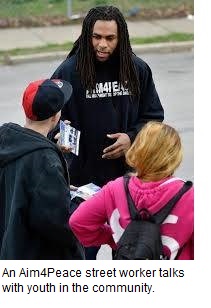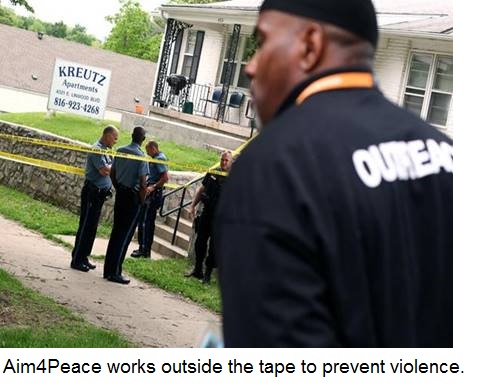AIM4PEACE TARGETS THE INFECTION OF VIOLENCE
by Marla Fogelman
|
"We don't judge," says Tracie McClendon–Cole, director of Kansas City's (KC's) violence prevention initiative Aim4Peace. This impartiality allows McClendon–Cole and her staff of street workers to approach Kansas Citians caught up in violence with compassion and hands-on help, instead of punishment and blame. Using the Cure Violence model pioneered by epidemiologist Gary Slutkin, Aim4Peace treats violence as a communicable disease that must be interrupted to eliminate its spread.1
McClendon–Cole says an epidemiological approach made sense for KC, which has a history of challenges related to racial segregation and associated health disparities.
Public health was also the catalyst for bringing the issue of violence to the city's attention. In 2000, after the Kansas City Health Department (KCHD) released a report on homicide as the third leading cause of death in the city's minority community, local government established a health commission and immediately began planning a community-based collaborative process to respond. But it wasn't until 2006, after the Commission on Violent Crime submitted its youth violence report, that McClendon–Cole and other members of the commission started searching for an evidence-based, public health strategy to bring home the message that shooting and killing are "no longer normal" behaviors.2,3
The commission was looking for something other than "traditional methods," says McClendon–Cole, and began studying a number of models—both in the United States and other countries—that would be compatible with KC's racially diverse and divided population.
As a result of their search, and having learned the findings from a Department of Justice study on reducing shootings, the city decided to adapt the model used by Cure Violence in Chicago.
"Kansas City already had the criminal justice tools," McClendon–Cole says, "but we wanted to look at the public health sector and apply that map to violence."
A Three-Pronged Approach
Launched by the KCHD in 2008, Aim4Peace became one of the first two Cure Violence–based initiatives outside of Chicago. To address the "primary infection" of violence, the model uses a three-part approach: 1) Identify, detect, and increase awareness of the perceived risk and costs of involvement in violence among the target population; 2) Provide alternatives to violence when individuals in the community are making unhealthy behavior decisions; and 3) Support healthy community norms and behaviors regarding violence.2
 Using Credible Messengers
Using Credible Messengers
Consistent with the Cure Violence public health approach, one of the most effective aspects of Aim4Peace's treatment plan is the use of violence interrupters or "credible messengers," who have lived in or are known in neighborhoods where the program is being applied. McClendon–Cole, who holds a law degree from the University of Missouri–Kansas City and a master's in public education from the University of Kansas, likes to say these workers have a "doctorate in streetology" that is as valuable as any of her credentials. "I call them public health workers," she says.
Rashid Junaid, Aim4Peace violence prevention manager, echoes her sentiment on the community's respect for street workers. "We're like pioneers," he says. "People believe in us."
Aim4Peace workers receive a cadre of trainings on conflict resolution and mediation, mental health, and trauma. They have one-on-one weekly meetings with a supervisor and are required to document incidents in which they have intervened. First and foremost, their task is to reduce the risk of violence among Aim4Peace participants from high to low.
Workers show up at schools, homes, and even emergency rooms after a stabbing or shooting has occurred to quell potential acts of retaliatory violence. They have to "avoid butcher knives and assault rifles and use all the conflict resolution skills they've got," says Junaid.
Yet, trying to interrupt violence while also avoiding personal danger can take its toll on even the most well-respected neighborhood icons, and some have experienced secondary trauma. Despite the risks, many workers find great satisfaction in carrying out the Aim4Peace mission and have stayed with the program for years.
Fostering Collaborations
In addition to the credible messengers, another way Aim4Peace has spread its message is through collaborations with multiple stakeholders. The program has partnered with the police department, school system, community centers, and the Truman Medical Center Hospital Prevention Program. McClendon–Cole has particular praise for the KC police department, which has been supportive since the program's inception.
"They've been very influential," she says, "because they subscribe to the idea that 'you can't lock your way out of [the problem].'"
Aim4Peace also partners with an evaluation team from the University of Kansas to measure and manage outcomes—a critical piece of any evidence-based program.
McClendon–Cole cites the strength of her team in bringing disparate groups of stakeholders together. "If you have a 'can do' spirit, as this team does," she says, "you don't get told 'no' too often." While modest about her own efforts, she attributes her "focus on the positive" attitude to parents who taught her "there is always a way you can overcome."
 Promoting Positive Outcomes for Kansas City
Promoting Positive Outcomes for Kansas City
Although trying to overcome the spread of violence may seem as daunting as setting out to cure the most virulent forms of cancer, Aim4Peace has contributed to positive outcomes for the city's health. In 2014, the program helped achieve an overall reduction in citywide homicides by 25 percent and a decrease of 70 percent within intervention zones. Aim4Peace also brokered sustained peace in 156 conflict resolutions, responded to 68 incidents of intentional injuries (a positive reduction from 115 in 2013), and provided 448 unduplicated alternatives to violence (conflict resolution skill building and effective parent education training) to community residents, patients, and their families.2 The program's success in reducing incidents of trauma was also recently featured in U.S. News & World Report.4
Looking Toward Sustainability
Aim4Peace has made great strides, especially since receiving an Office of Juvenile Justice and Delinquency Prevention grant in 2013. But to keep the program sustainable, McClendon–Cole advocates looking at campaigns for other public health epidemics that organize initiatives on multiple levels. She proposes trying to obtain title grants through the federal government or—even better—a national fund that would support violence prevention, similar to the Ryan White HIV/AIDS initiative. According to McClendon–Cole, "the right timing, the right people, and the right level of influence" are also critical for maintaining the program's success.
McClendon–Cole is optimistic about what the public health model can do to treat violence now and in the future. As she says, it gets to the "heart and soul of the issue in a way that hasn't been done before."
|
|
|
